Complete Solutions to JEE Main And Advanced of chapter THERMODYNAMICS AND THERMOCHEMISTRY of Class 12 book with complete answers and questions
| Class 12 | CHEMISTRY |
| Chapter | THERMODYNAMICS AND THERMOCHEMISTRY |
| IIT-JEE PREVIOUS YEAR | JEE Main And Advanced |
| Number Of Questions | 83 |
| Academic Year | 2023-24 |
`deltaU` is equal to
01:31View Solutionone mole of an ideal gas at 300k in themal contact with surroundings exponds isothermally from 1.0 L to 2.0 L against a constant presses of 3.0 atm. In this process. The change in entrogy of surrroundings `(DeltaS)` in `J^(-1)` is
(1 L atm = 101.3 J)04:49View SolutionThe standed free energy of fromation of NO(g) is 86.6 kj/ mol at 298 K what is the standed free energy of fromation of ` NO^(2) g` at 298 k? `K _(p)= 1.6 xx 10^(12)`
07:34View SolutionFor the process, `H_(2)O(l) to H_(2)O(g)`
04:20View SolutionFor the process `H_(2)O(l) (1 "bar", 373 K) rarr H_(2)O(g) (1"bar", 373 K)` the correct set of thermodynamic parameters is
03:00View SolutionThe value of `log_(10)K` for a reaction `A hArr B` is (Given: `Delta_(f)H_(298K)^(Theta) =- 54.07 kJ mol^(-1)`,
`Delta_(r)S_(298K)^(Theta) =10 JK^(=1) mol^(-1)`, and `R = 8.314 J K^(-1) mol^(-1)`02:44View SolutionThe direct conversion of `A` to `B` is difficult, hence it is carried out as
`A rarr C rarrD rarr B`
Given, `DeltaS_((A^rarrC)) = 50 eU,DeltaS_((C^rarrD))=30eU,DeltaS_((BrarrD))=20 eU`, where `eU` is entropy unit. Thus the change in entropy in `(A rarrB)` is:01:51View SolutionA monoatomic ideal gas undergoes a process in which the ratio of `P` to `V` at any istant is constant and equal to unity. The molar heat capacity of the gas is
03:45View SolutionOne mole of monoatomic ideal gas at `T(K)` is exapanded from `1L` to `2L` adiabatically under constant external pressure of `1` atm . The final tempreture of gas in kelvin is
02:25View SolutionTwo moles of an ideal gas expanded isothermally and reversibly from `1L` to `10L` at `300K`. What is the enthalpy change?
01:20View SolutionSpontaneous adsorption of a gas on solid surface is an exothermic process because
03:01View SolutionOne mole of a non-ideal gas undergoes a change of state `(2.0atm,3.0L,95K)rarr(4.0atm,5.0L,245K)`
With a change in internal energy `DeltaE=30L` atm. The change in enthalpy `(DeltaH)` in the process in `L`-atm is03:09View SolutionWhich of the following statements is flase?
04:22View SolutionIn thermodynamics, a process is called reversible when
01:46View SolutionFor an endothermic reaction, where `Delta H` represents the enthalpy of reaction in `kJ mol^(-1)`, the minimum value for the energy of activation will be
02:51View SolutionThe difference between the heats of reaction at constant pressure and a constant volume for the reaction `2C_(6)H_(6)(l) + 15O_(2)(g) rarr 12CO_(2)(g) + 6H_(2)O(l)` at `25^(@)C` in `kJ` is
03:08View SolutionAn ideal gas in thermally insulated vessel at internal `(pressure)=P_(1), (volume)=V_(1)` and absolute `temperature = T_(1)` expands irreversiby against zero external, pressure , as shown in the diagram,
The final internal pressure, volume and absolute temperature of the gas are `p_(2), V_(2) and T_(2)`, respectively . For this expansion
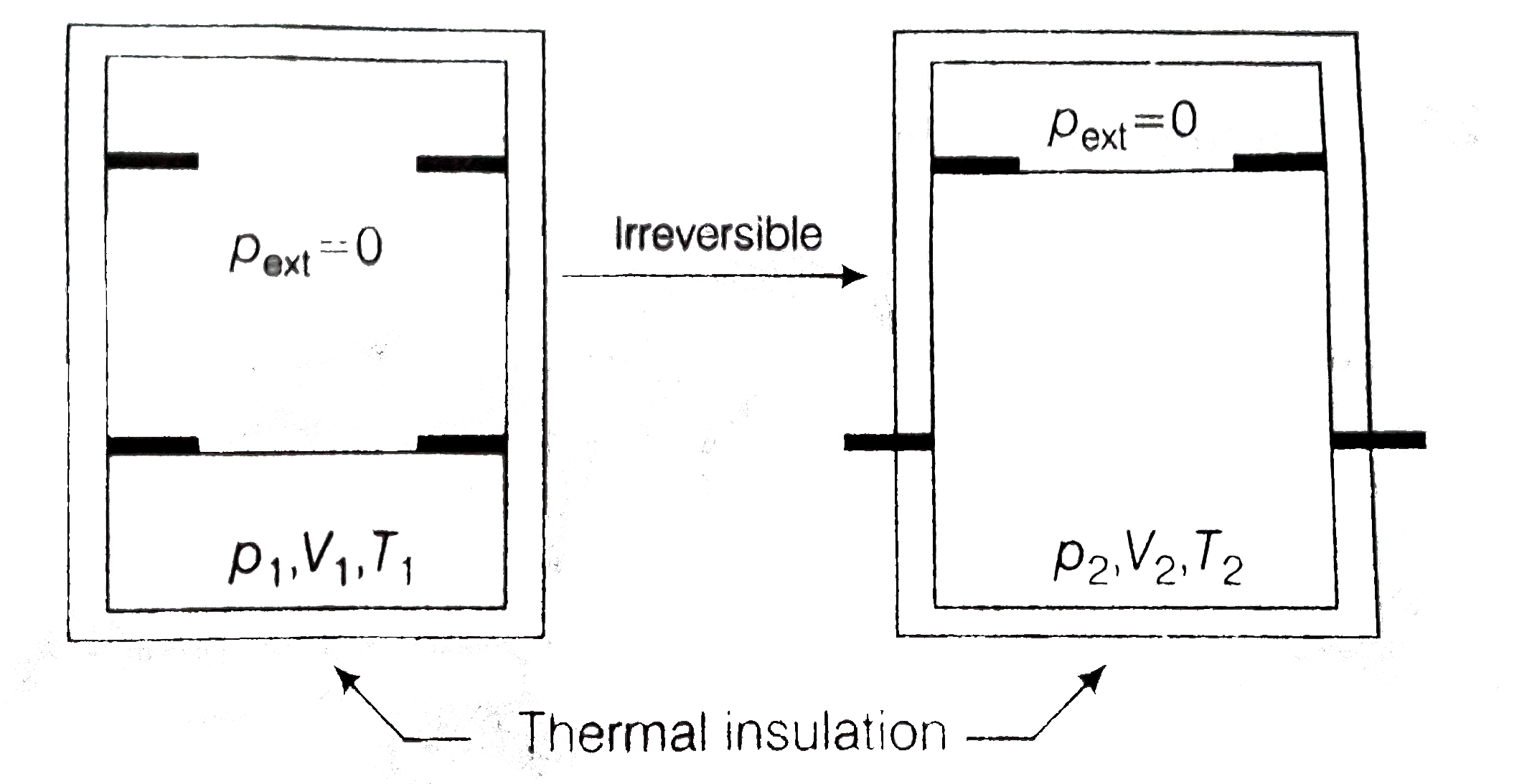 02:49View Solution
02:49View SolutionBenzene and naphthalene form an ideal solution at room temperature. For this process,the true statement(s) is (are)
01:31View SolutionThe reversible expansion of an ideal gas under adiabatic and isothermal conditions is shown in the figure. Which of the following statement(s) is (are) correct?
 11:23View Solution
11:23View SolutionFor an ideal gas, consider only `P-V` work in going from an initial state `X` to the final state `Z`. The final state `Z` can be reached by either of the two paths shown in the figure. Which of the following choice(s) is (are) correct? [Take `DeltaS` as change in entropy and `w` as work done]
 06:44View Solution
06:44View SolutionAmong the following, the intensive property is (properties are) :
02:40View SolutionAmong the following , the state funcation (s) is (are)
03:16View SolutionIdentify the extensive quantities from the following
(i) refractive
(ii) volume
(iii) temperature
(iv) enthalpy03:40View SolutionAssertion (A) : There is a natural asymmetry between converting work to heat and converting heat of work.
Reason (R ) : No process is possible in which the sole result is the absorption of heat from a reservoir and its complete conversion into work.02:04View SolutionAssertion (A): For every chemical reaction at equilibrium, standard Gibbs enegry of the reaction is zero.
Reason (R ) : At constant temperature and pressure chemical reactions are spontaneous in the direction of the decreasing Gibbs energy.02:43View SolutionAssertion: The heat absorbed during the isothermal expansion of an ideal gas against vacuum is zero.
Reason: The volume occupied by the molecules of an ideal gas is zero.04:05View SolutionA fixed mass m of a gas is subjected to transfromation of states from K to L to M and back to K as shown in the figure.

The pair of isochoric processes among the transfromation of states is01:24View SolutionA fixed mass `m` of a gas is subjected to transformation of state: `K` to L to `M` and back to `K` as shown in the figure.
The succeeding operations that enabel this transformation of state are
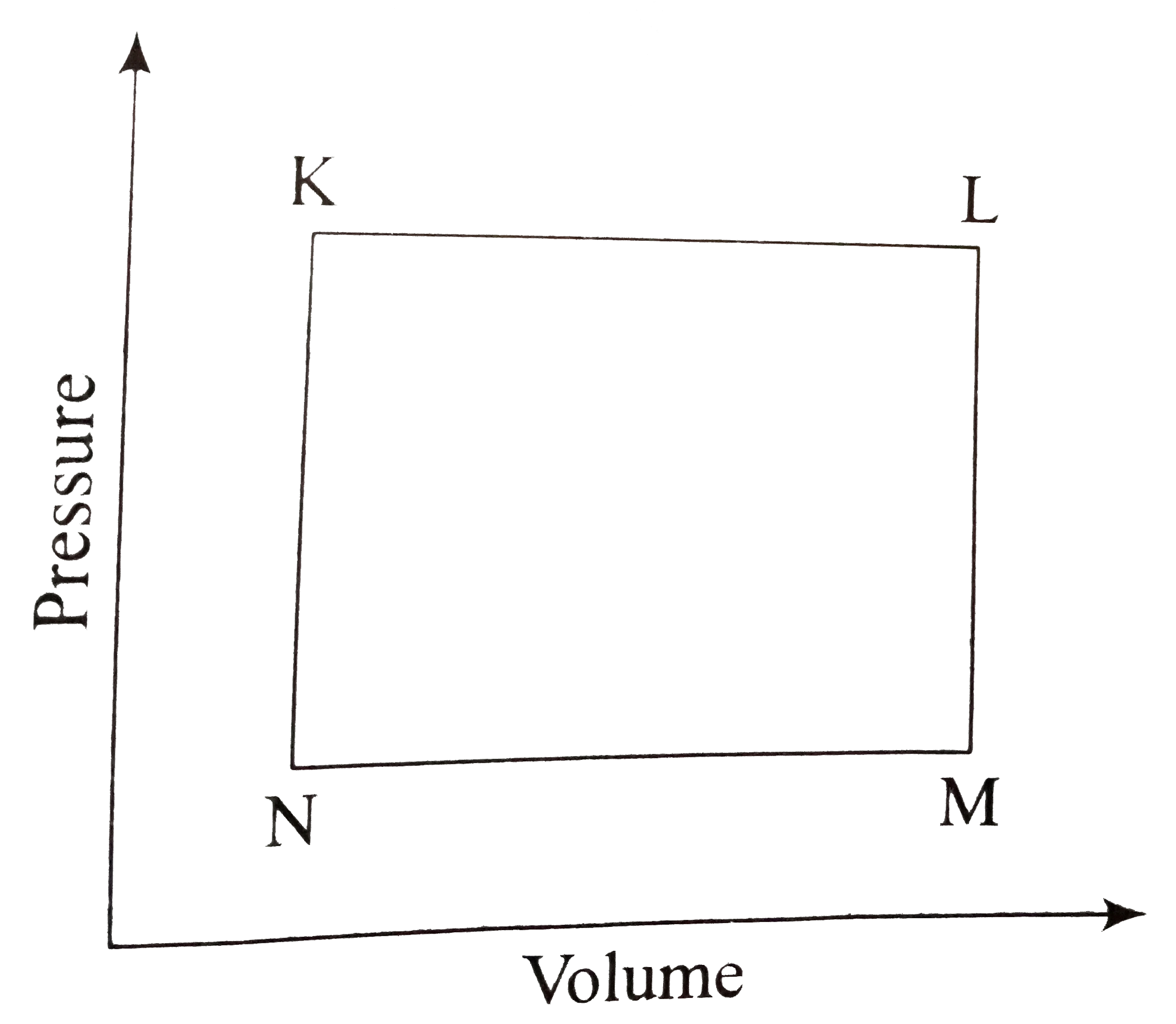 09:20View Solution
09:20View SolutionMatch the thermodynamic processes given under column I with the expressions given under column II.
 13:07View Solution
13:07View SolutionMatch the transformations In column I with appropriate options in column II.
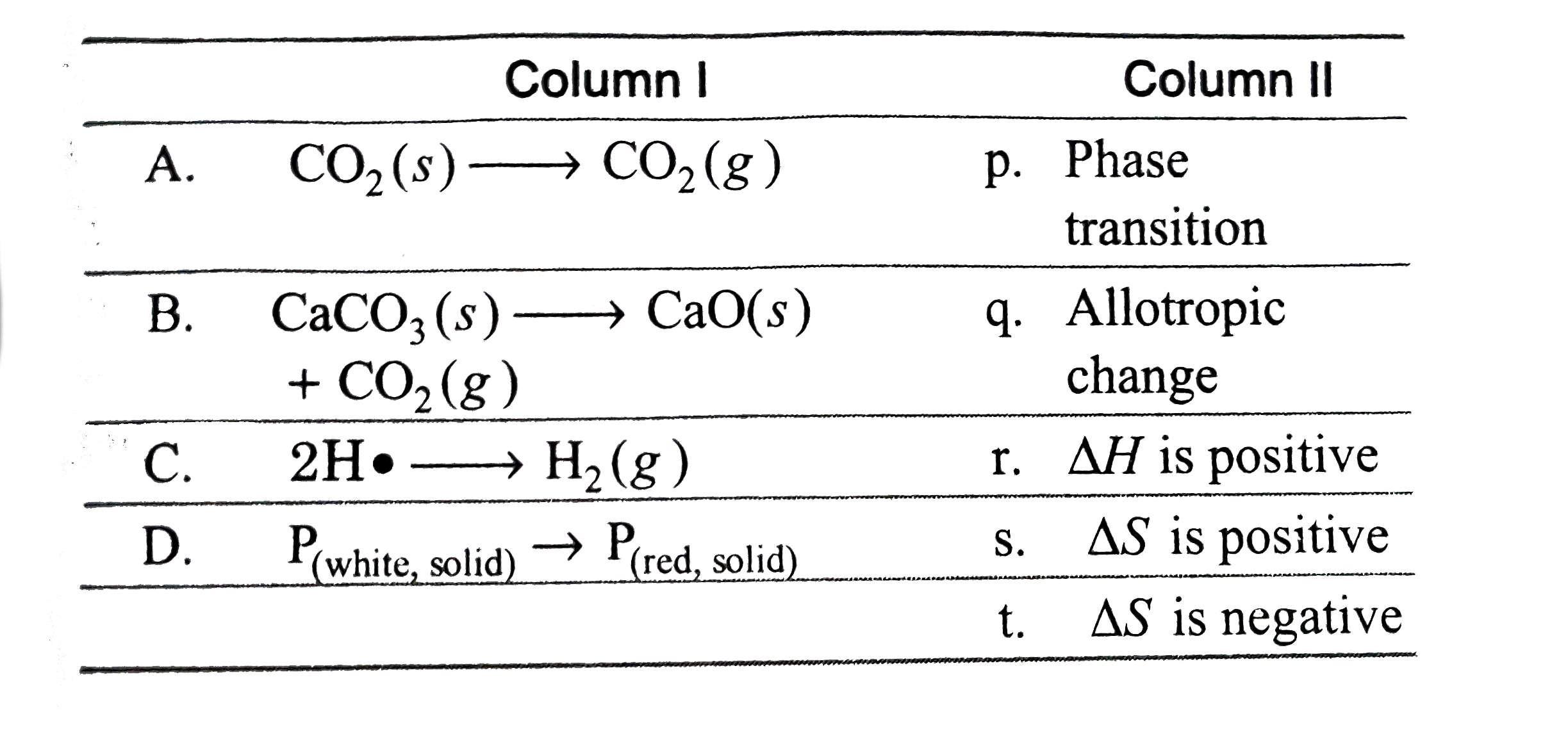 06:24View Solution
06:24View SolutionEnthalpy is an ……………….. property.
01:42View SolutionWhen `Fe_(S)` is dissovled in aqueous hydrochloric acid in a closed vessel the work done is __________
01:33View SolutionThe heat content of the products is more than that of the reactants in an…………….reaction.
01:49View SolutionA system is said to be………..if it can neither exchange matter nor energy with the surrounding's.
01:10View Solution`C_(P) -C_(V)` for an ideal gas is………….. .
03:00View SolutionThe total energy of `1mol` of an ideal monatomic gas at `27^(@)C` is……. .
02:11View SolutionThe first law of thermodynamics is not adequate in predicting the direction of a process.`(True"/"False)`
01:30View SolutionThe heat capacity of a diatomic gas is higher than that of a mono-atomic gas. `(True"/"False)`
01:46View SolutionFor the reaction
`2CO +O_(2) rarr 2CO_(2), DeltaH =- 560 kJ`,
`2mol` of `CO` and `1mol` of `O_(2)` are taken in a container of volume `1L`. They completely form `2 mol` of `CO_(2)`. The gaseous deviate appreciably from ideal behaviour. If the pressure in the vessel changes from `70` to `40atm`, find the magnetic (absolute) value of `DeltaU at 500K. (1 L-atm = 0.1 kJ)`04:43View Solution`100mL` of a liquid is contained in an insulated container at a pressure of 1bar. The pressure is steeply increased to `100`bar. The volume of the liquid is decreased by `1mL` at this constant pressure. Find `DeltaH` and `DeltaU`.
06:20View SolutionTwo moles of a perfect gas undergo the following process: (a) A reversible isobaric expansion from (`1.0` atm, `20.0` litre) to (`1.0` atm,`40.0`litre). (b) A reversible isochoric change of state from (`1.0` atm, `40.0` litre) to (`1.0` atm, `40.0` litre). (b) A reversible isochoric change of state from (`1.0` atm, `40.0` litre) to (`0.5` atm, `40.0` litre). (c) A reversible isothermal compression from (`0.5`atm, `40.0` litre) to (`1.0` atm, `20.0` litre). (i) Sketch with labels each of the process on the same `P-V` diagram. (ii) Calculate the total work `(W)` and the total heat change `(q)` involved in the above process. (iii) What will be the value of `DeltaU, DeltaH` and `DeltaS` for the overall process?
11:34View SolutionWhen `1`pentyne `(A)` is treated with `4N` alcoholic `KOH` at `175^(@)C`, it is slowly converted into an equilibrium mixture of `1.3%` of `1`pentyne `(A), 95.2% 2`-pentyne `(B)` and `3.5%` of `1,2`-pentandiene `(C )`. The equilibrium was maintained at `175^(@)C`. calculate `DeltaG^(Theta)` for the following equilibria:
`B hArr A, DeltaG^(Theta)underset(1) = ?`
`B hArr C, DeltaG^(Theta)underset(2) =?`
From the calculated value of `DeltaG^(Theta)underset(1)`and `DeltaG^(Theta)underset(2)`, indicate the order of stability of `A,B` and `C`.11:57View SolutionShow that the reaction
`CO(g) +(1//2)O_(2)(g) rarr CO_(2)(g)`
at `300K` is spontaneous and exothermic, when the standard entropy change is `-0.094 k J mol^(-1) K^(-1)`. The standard Gibbs free energies of formation for `CO_(2)`and `CO` are `-394.4`and `-137.2kJ mol^(-1)`, respectively.05:00View SolutionA sample of argon gas at `1atm` pressure and `27^(@)C` expands reversibly and adiabatically from `1.25 dm^(3)` to `2.50 dm^(3)`. Calculate the enthalpy change in this process. `C_(vm)` for orgon is `12.48J K^(-1) mol^(-1)`.
05:41View SolutionA gas mixture of `3.67L` of ethylene and methane on complete combustion at `25^(@)C` produces `6.11 L` of `CO_(2)`. Find out the heat evolved on buring `1L` of the gas mixture. The heats of combustion of ethylene and methane are `-1423` and `-891kJ mol^(-1)`, respectively, at `25^(@)C`.
09:36View SolutionAn athelete is given `100g` of glucose `(C_(6)H_(12)O_(6))` of energy equivalent to `1560 kJ`. He utilises `50%` of this gained enegry in the event. In order to avoid storage of enegry in the body, calculate the weight of water he would need to perspire. The enthalpy of evaporation of water is `441kJ//mol`.
02:32View SolutionThe following statement is true only under some specific conditions. Write the conditions for the following statement in not more than two sentences.
The heat energy q absorbed by a gas is `DeltaH`.04:45View SolutionWith the help of thermochemical equations given below, determine `Delta_(r )H^(Θ)` at `298 K` for the following reaction:
`C("graphite")+2H_(2)(g) rarr CH_(4)(g),Delta_(r )H^(Θ) = ?`
`C("graphite")+O_(2)(g) rarr CO_(2)(g),
Delta_(r )H^(Θ) = -393.5 kJ mol^(-1)` ...(1)
`H_(2)(g) +1//2O_(2)(g) rarr H_(2)O(l)`,
`Delta_(r )H^(Θ) = -285.8 kJ mol^(-1)` ...(2)
`CO_2(2)(g)+2H_(2)O(l) rarr CH_(4)(g)+2O_(2)(g)`,
`Delta_(r )H^(Θ) = +890.3 kJ mol^(-1)` ...(3)03:45View SolutionThe enthalpies of combustion of carbon and carbon monoxide are `-393.5` and `-282.5KJmol^(-1)` respectivaly. The enthalpy of formation of carbon monoxide per mole is:
03:39View SolutionFor the complete combustion of ethanol, `C_(2)H_(5)OH(l)+3O_(2)(g)rarr2CO_(2)(g)+3H_(2)O(l)` the amount of heat produced as measured in bomb calorimeter is `1364.47KJ mol^(-1)` at `25^(@)C` . Assuming ideality, the enthalpy of combustion, `DeltaH_(C)` , for the reaction will be
`[R=8.314JK^(-1)mol^(-1)]`04:14View SolutionThe standard enthalpies fo formation of `CO_(2) (g), H_(2) O (1)`, and glucose (s) at `25^(@)C` are `- 400 kJ mol^(-1), - 300 kJ mol^(-)`, and `- 1300 kJ mol^(-1)`, respectively. The standard enthalply of combustion per gram of glucose at `25^(@)C` is
06:21View SolutionUsing the data provided, calculate the multiple bond energy `(kJ mol^(-1))` of a `C-=C` bond in `C_(2)H_(2)`. That energy is `(` take the bond energy of a `C-H` bond as `350kJ mol^(-1))`.
`2C_((s))+H_(2(g))rarr C_(2)H_(2(g)), Delta=225kJ mol^(-1)`
`2C_((s))rarr 2C_(g)), DeltaH=1410kJ mol^(-1)`
`H_(2(g)) rarr 2H_((g)),DeltaH=330kJ mol^(-1)`04:39View SolutionThe species which by definition has zero standard molar enthalpy of formation at `298K` is
02:02View SolutionThe bond energy (in kcal `mol^(-1))` of a `C -c` single bond is approximately
01:52View Solution`Delta_(vap)H = 30 kJ mol^(-1)` and `Delta_(vap)S = 75 Jmol^(-1)K^(-1)`. Find the temperature of vapour, at `1` atm.
02:17View SolutionWhich of the reaction defines `Delta_(f)H^(@)` ?
02:20View Solution`Delta H_(1)^(@)` for `CO_(2)(g)`, `CO(g)` and `H_(2)O(g)` are `-393.5,-110.5` and `-241.8 kJ mol^(-1)` respectively. Standard enthalpy change for the reaction
`CO_(2)(g)+H_(2)(g) rarr CO(g) + H_(2)O(g)` is02:43View SolutionThe following is (are) endothermic reaction (s)
06:49View SolutionIn a constant volume calorimeter, `3.5 g` of a gas with molecular weight `28` was burnt in excess oxygen at `298.0 K`. The temperature of the calorimeter was found to increase from `298.0 K to 298.45 K` due to the combustion process. Given that the heat capacity of the calorimeter is `2.5 kJ K^(-1)`, find the numerical value for the enthalpy of combustion of the gas in `kJ mol^(-1)`
04:07View SolutionThe standard heat of formation values of `SF_(6)(g), S(g)`, and `F(g)` are `-1100, 275`, and `80 kJ mol^(-1)`, respectively. Then the average `S-F` bond enegry in `SF_(6)`
05:32View SolutionFrom the following data, calculate the enthalpy change for the combustion of cyclopropane at `298K`. The enthalpy of formation of `CO_(2(g)),H_(2)O_((l))` and `Propen e_((g))` are `-393,-285.8` and ` 20.42 kJ mol^(-1)` respectively. The enthalpy of isomerisation of cyclopropane to propene is `-33.0kJ mol^(-1)`
10:41View SolutionCompute the heat of formation of liquie methyl alcohol is kilojoule per mol using the following data. Heat of vaporisation of liquid methyl alcohol `=38kJ//mol`. Heat of formation of gaseous atoms from the elements in their standard states `:H=218kJ // mol, C=715kJ //mol, O=249kJ //mol.`
Average bond energies`:`
`C-H415kJ//mol, C-O 356kJ//mol, O-H 463kJ //mol.`08:53View SolutionThe standard molar enthalpies of formation of cyclohexane (l) and benzene (l) at `25^(@)C` are `-156` and `+49 kJ mol^(-1)`, respectively. The standard enthaly of hydrogenation of cyclohenxene (l) at `25^(@)C` is `-119 kJ mol^(-1)` Use this data to estimate the magnitude of the resonance enegry of benzene.
06:56View SolutionThe polymerisation of ethylene to linear polyethylene is represented by the reaction
`nCH_(2)=CH_(2)rarr(-CH_(2)-CH_(2)-)_(n)`
When `n` has a large integral value. Given theat the average enthalpies of bond dissociation for `C=C` and `C-C` at `298K`are `+590` and `+331kJ mol^(-1)` respectively, calculate the enthalpy of polymerisation per mole of ethylene at `298K`.02:38View SolutionIn order to get maximum calorific output a burner should have an optimum fuel to oxygen ratio which corresponds to three times as much oxygen as is required theorectically for complete combusion of the fuel A burner which has been adjused for methane as fuel (with `x L h^(-1)` of `CH_(4)` and `6x Lh^(-1) of CO_(2))` is to be readjusted for butane `C_(4)H_(10)` in order to get the same calorific output what should be the rate of supply to butane and oxygen? Assume that losses due to incomplete combustion etc are the same for both fuels and that the gases behave ideally Heats of combusion
`CH_(4) =809 kJ mol^(-1),C_(4)H_(10) =2878 kJmol^(-1)` .11:36View SolutionDetermine enthalpy change for,
`C_(3)H_(8(g))+H_(2(g))rarr C_(2)H_(6(g))+CH_(4(g))`
at `25^(@)C` using heat of combustion values under standard condition.
`{:(Compounds,H_(2(g)),CH_(4(g)),C_(2)H_(6(g)),C_((Graph ite))),(DeltaH^(@)i n kJ//mol,-285.8,-890.0,-1560.0,-393.5):}`
The standard heat of formation of `C_(3)H_(8(g))` is `-103.8 kJ mol^(-1)`.08:01View SolutionUsing the data `(` all vaues in `kcal mol^(-1) at 25^(@)C)` given below, calculate bond energy of `C-C` and `C-H` bonds.
`C_((s))rarr C_((g)), DeltaH=172`
`H_(2) rarr 2H, DeltaH=104`
`H_(2)+(1)/(2)O_(2) rarr H_(2)O_((l)), DeltaH=-68.0`
`C_((s))+O_(2) rarr CO_(2), Delta H=-94.0`
Heat of combustion of `C_(2)H_(6)=-372.0`
Heat of combustion of `C_(3)H_(8)=-530.0`14:07View SolutionThe enthalpy of combustion of `H_(2)` , cyclohexene `(C_(6)H_(10))` and cyclohexane `(C_(6)H_(12))` are `-241` , `-3800` and `-3920KJ` per mol respectively. Heat of hydrogenation of cyclohexene is
02:35View SolutionAn intimate mixture of ferric oxide and aluminium is used as solid fuel in rockets. Calculate the fuel value per `cm^(3)` of the mixture.
Heats of formation and densities are as follows:
`H_(f(AI_(2)O_(3)))^(Theta)=-399kcal mol^(-1),H_(f(Fe_(2)O_(3)))^(Theta)=-199kcal mol^(-1)`
Density of `Fe_(2)O_(3)=4.0 g cm^(-3)`, Density of `Al = 2.0 g cm^(-3)`06:58View SolutionThe standard molar heats of formation of ethane, carbon dioxide, and liquid water are `-21.1, -94.1`, and `-68.3kcal`, respectively. Calculate the standard molar heat of combustion of ethane.
08:00View SolutionThe bond dissociation energy of gaseous `H_(2),Cl_(2)` and `HCl` are `104,58` and `103 kcal mol^(-1)` respecitvely. Calculate the enthalpy of formation for `HCl` gas.
02:38View SolutionGiven the following standard heats of reactions:
(a) heat of formation of water `= -68.3 kcal`, (b) heat of combustion of `C_(2)H_(2) =- 310.6 kcal`, (c ) heat of combustion of ethylene `=- 337.2 kcal`. Calculate the heat of reaction for the hydrogenation of acetylene at constant volume and at `25^(@)C`.06:56View SolutionGiven that:
i. `C(s) + O_(2)(g) rarr CO_(2)(g) , DeltaH =- 94.05 kcal`
ii. `H_(2)(g) +(1)/(2) O_(2)(g) rarr H_(2)O(l), DeltaH =- 68.32 kcal`
iii.`C_(2)H_(2)(g) +(5)/(2) O_(2)(g) rarr 2CO_(2)(g) +H_(2)O(l), DeltaH =- 310.62 kcal`
The heat of formation fo acetylene is06:29View SolutionThe standared enthalpies of formation at `298K` for `C C1(g), H_(2)O(g), CO_(2)(g)` and `HC1(g)` are `-106.7, -241.8, -393.7`, and `-92.5kJ mol^(-1)`, respectively. Calculate `DeltaH^(Theta)underset(298K)` for the reaction
`C C1_(4)(g) +2H_(2)O(g) rarr CO_(2)(g) +4HCI_(g)`02:15View SolutionThe enthalpies for the following reactions `(DeltaH^(Theta))` at `25^(@)C` are given below.
a. `(1)/(2)H_(2)(g) +(1)/(2)O_(2)(g) rarr OH(g)`
`DeltaH = 10.06 kcal`
b. `H_(2)(g) rarr 2H(g), DeltaH = 104.18 kcal`
c. `O_(2)(g) rarr 2O(g), DeltaH = 118.32 kcal`
Calculate the `O-H` bond energy in the hydroxyl radical.06:29View Solutionthe standed reaction free energy for
`N_(2)O_(4)(g) to 2NO_(2)is DeltaG^(@) = + 4.73 kJ mol ^(-1)` at 298 K . What is value of `DeltaG` and what is the spontaneous direction of the reaction when the partical pressure fo the gases are `P_(N_(2)O_(4))= 0.80 atm and P_(NO_(2))= 2.10 atm?`04:05View Solutionwe consider a grwing plant. Limting our system to plant itself, to be an exmple of decreasing entropy, small molecules,like carbon dioxide, `CO_(2)` and water `H_(2)O` are built into complex but orderly arroangements of macromolecules, which one of the follwing statement applies?
02:29View SolutionOne mole of a monationc ideal gas intially at a pressure of 2.00 bar and a temperature of 300 K is taken to a final pressure of 4.00 bar by a reversible path defined by ` P//V = constant. Taking C_(v)` to be equal to `12.5 J mol ^(-1) K^(-1)` The correct dedution for this process is (are)
10:33View SolutionHow much heat flows into the system along path ADB it the work done by the system is 10 J?
When a system is taken from state A to state B along the parth ACB in the figure below ,80 j of heat flows into the system and the system does 30 J of work.
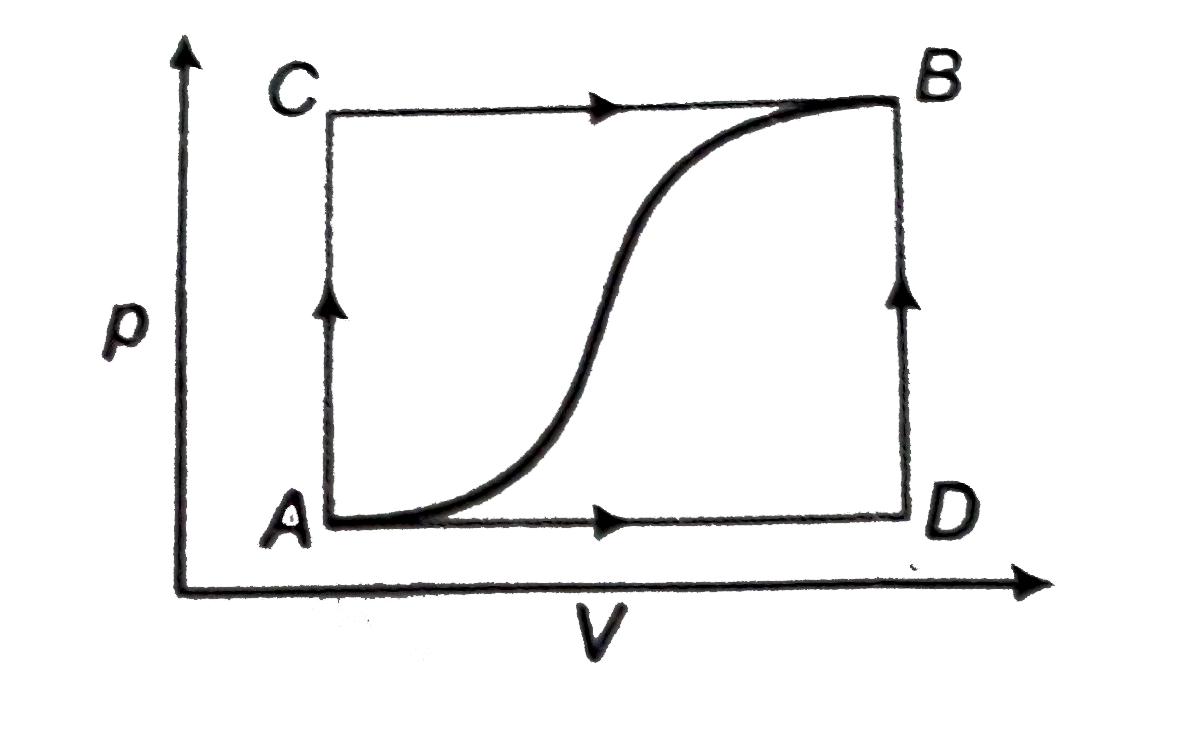 07:51View Solution
07:51View SolutionWhen the system is retuned form state B to A along the curved path, the work doen on the system is 20 J Does the system absorb ro liberate heat, and how much?
When a system is taken from state A to state B along the parth ACB in the figure below ,80 j of heat flows into the system and the system does 30 J of work.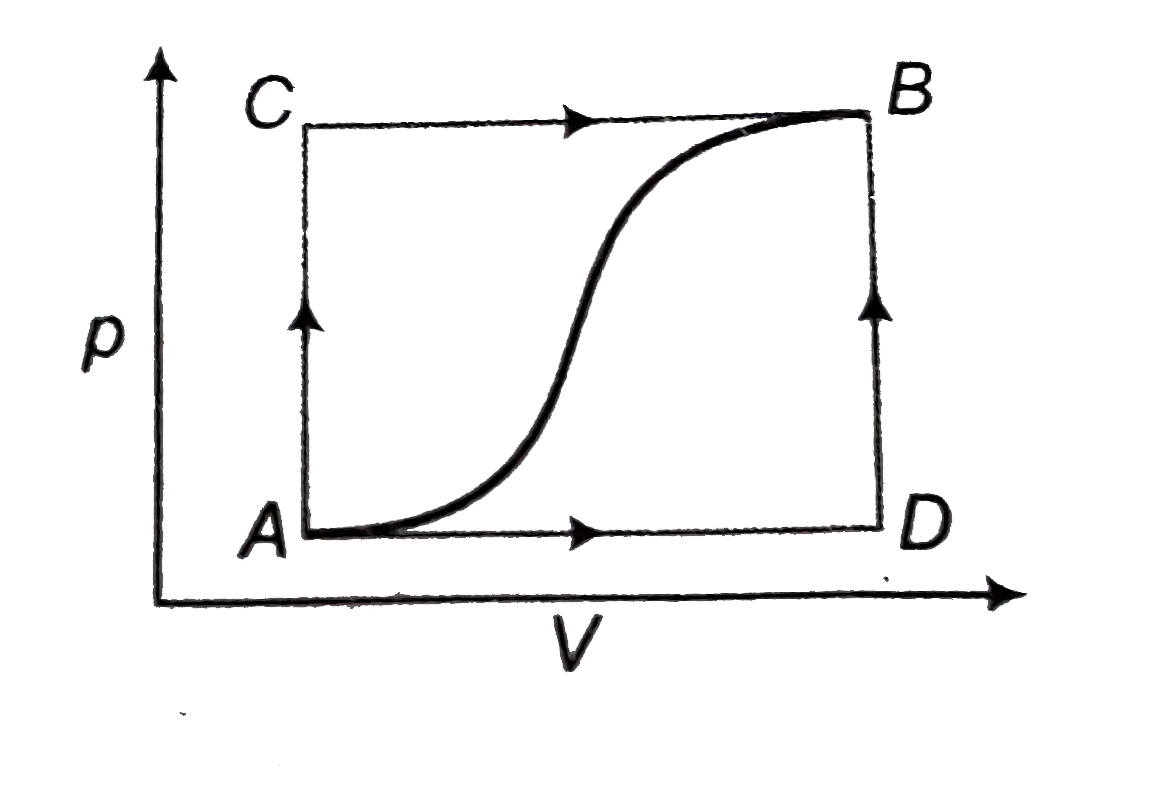 09:40View Solution
09:40View SolutionAssertion All reversible reaction proceeds in direction of lower Gibbs' energy.
Reson Reversible reaction proceeds spontaneously towards a state of equilibrium where the Gibbs' energy is minimum03:08View SolutionAssertion lsothemal expansion of ideal gas againt vacuum must be simultaneously adiabatic.
reason The work done by system in the above process is zero.03:43View SolutionMatch the statements of column I with values of column II.
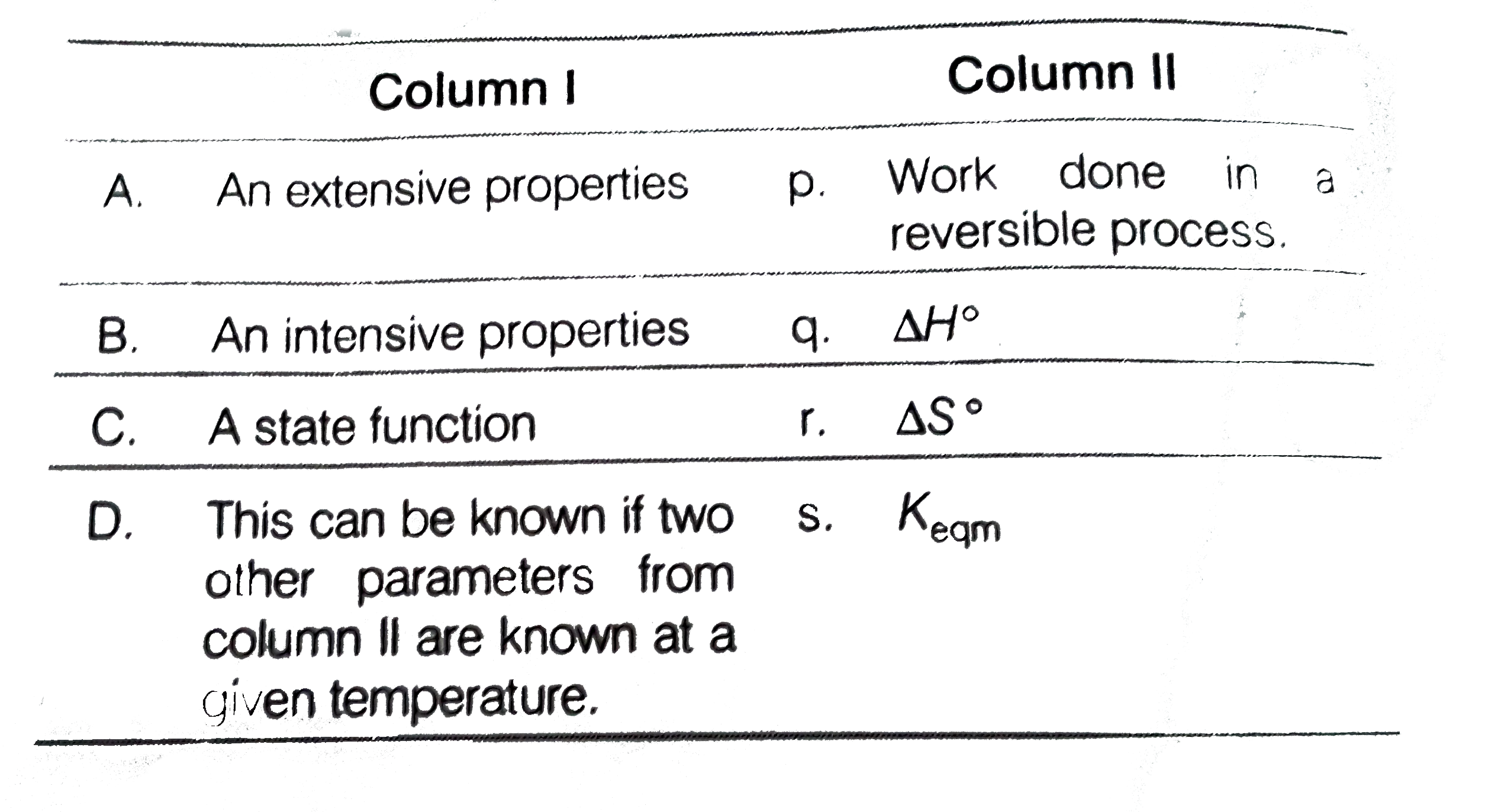 05:56View Solution
05:56View Solution
JEE Main And Advanced questions and complete solutions for chapter THERMODYNAMICS AND THERMOCHEMISTRY of IIT-JEE PREVIOUS YEAR (CHEMISTRY) of Class 12
